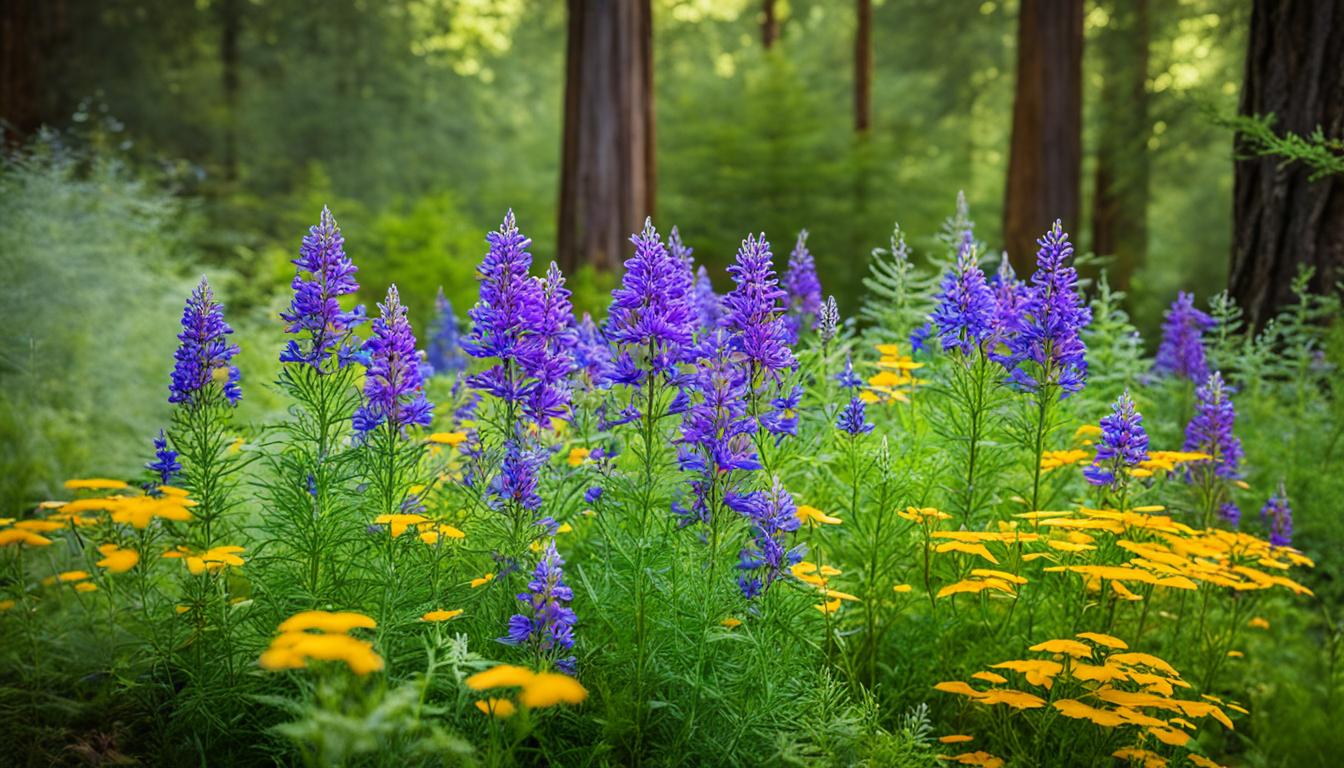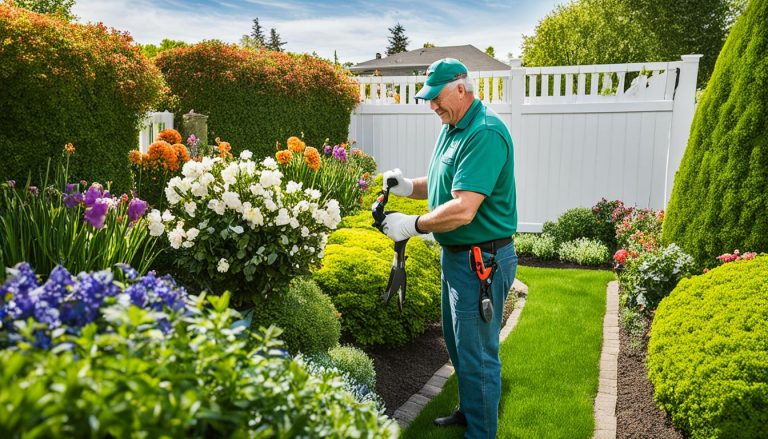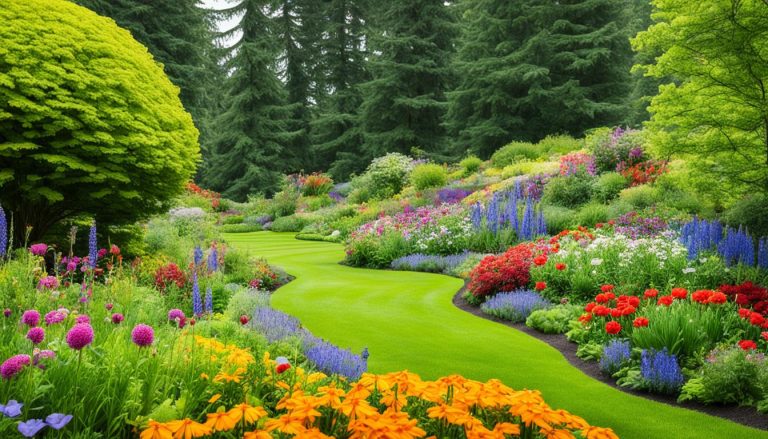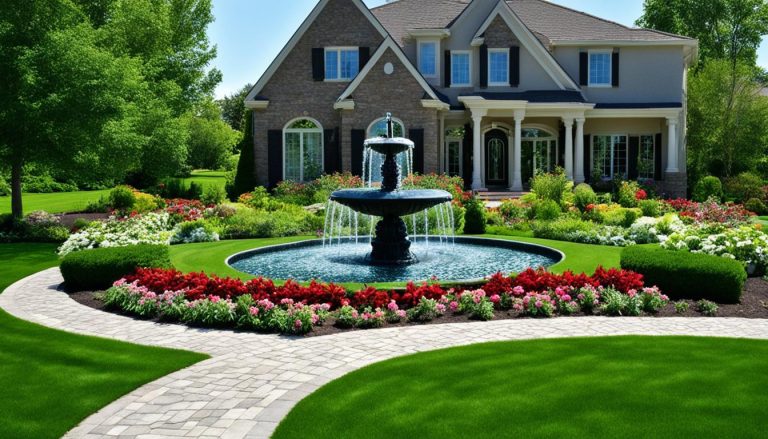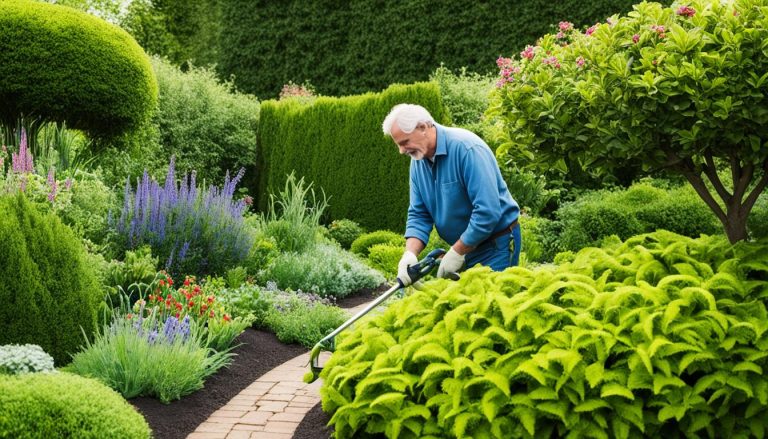Green Oasis: Sustainable Landscaping Techniques
Welcome to our comprehensive guide on creating an eco-friendly paradise with sustainable landscaping techniques. In this article, we will explore various methods to transform your outdoor space into a lush and eco-conscious oasis. By incorporating these sustainable practices, you can achieve a beautiful landscape that harmonizes with the environment while minimizing your carbon footprint.
Imagine stepping into a backyard filled with vibrant native plants, where the sound of birds and the buzz of pollinators harmonize with the gentle breeze. Picture a space that not only enhances the aesthetics of your home but also contributes to the health of our planet. With the right sustainable landscaping techniques, this vision can become a reality.
In our journey towards sustainable landscaping, we will cover a range of topics to help you create an eco-conscious space. From designing with native plants to conserving water, practicing organic pest control, implementing sustainable lawn care, and creating wildlife-friendly habitats, we’ve got you covered.
To kick things off, let’s dive into the world of native plants and how they can be the foundation of your sustainable landscape. Keep reading to learn more about designing with native plants for biodiversity and water conservation.
Are you ready to transform your yard into a lush and eco-conscious space? Let’s get started on this exciting journey towards sustainable landscaping!
Designing with Native Plants for Sustainable Landscaping
In the quest for a sustainable and eco-friendly garden, one of the key considerations is the use of native plants. These plants are uniquely adapted to the local environment and play a vital role in promoting biodiversity and water conservation. By incorporating native plants into your landscape design, you can create a beautiful and thriving garden that harmonizes with nature.
One of the biggest advantages of native plants is their ability to support local biodiversity. These plants have co-evolved with native wildlife, providing essential food and shelter for birds, insects, and other animals. By designing your garden with native plants, you can create a habitat that attracts and sustains a diverse range of species, contributing to the overall health of the ecosystem.
Native plants are also well-suited to local weather conditions, often requiring less water maintenance compared to non-native varieties. Their deep root systems help them access water from deeper soil layers, making them more resilient during droughts and reducing the need for excessive watering. This not only conserves water but also helps to mitigate the impact of water scarcity on the environment.
When incorporating native plants into your landscape, it is important to consider their specific needs and compatibility with other plants. Grouping plants with similar water and sunlight requirements can promote healthy growth and enhance the overall aesthetics of your garden. By selecting a diverse range of native plants, you can create an eco-conscious garden that reflects the beauty and resilience of the natural landscape.
Benefits of Designing with Native Plants:
- Promotes biodiversity and supports local wildlife populations
- Reduces water consumption and conserves precious resources
- Enhances the beauty and sustainability of your landscape
- Requires less maintenance and chemical inputs
- Contributes to the overall health of the ecosystem
| Native Plant | Biodiversity Contribution | Water Conservation | Drought Tolerance |
|---|---|---|---|
| Wild Bergamot (Monarda fistulosa) | Attracts butterflies, bees, and hummingbirds | Low water requirements once established | High drought tolerance |
| Eastern Redbud (Cercis canadensis) | Provides food and habitat for birds | Moderate water requirements | Moderate drought tolerance |
| Prairie Dropseed (Sporobolus heterolepis) | Supports ground-nesting birds and small mammals | Low water requirements once established | High drought tolerance |
Water Conservation Strategies for Sustainable Landscaping
In sustainable landscaping, water conservation plays a crucial role in minimizing wastage and preserving this precious resource. By implementing effective water conservation strategies, you can create an eco-friendly outdoor space that thrives even in dry climates. In this section, we will explore two key techniques for conserving water: rainwater harvesting and drip irrigation.
Rainwater Harvesting
Rainwater harvesting is a sustainable practice that involves collecting and storing rainwater for later use in the garden. This technique not only reduces the strain on municipal water supplies but also helps to minimize stormwater runoff and erosion. By harnessing nature’s gift, you can ensure a consistent water source for your plants while reducing your reliance on treated water.
There are several methods of rainwater harvesting, including the use of rain barrels, cisterns, and underground storage tanks. These containers capture rainwater from rooftops and other surfaces, allowing you to store it for future use. The collected rainwater can be used for watering plants, washing outdoor surfaces, or replenishing ponds and fountains.
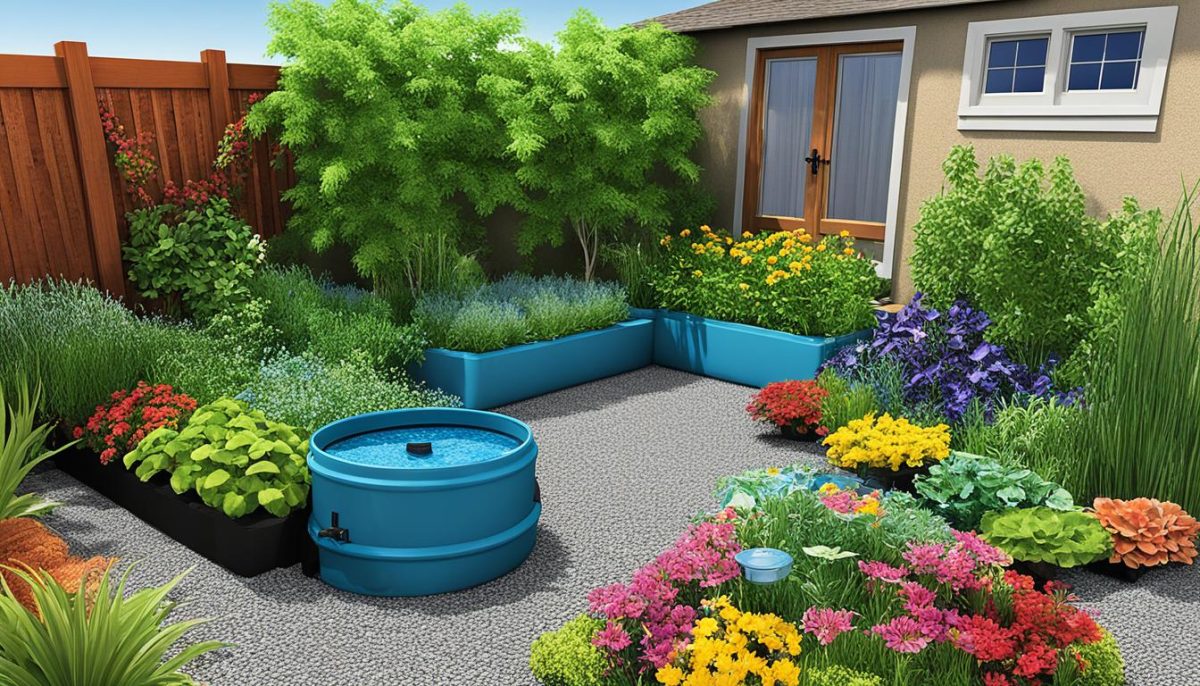
Drip Irrigation
Drip irrigation is an efficient watering system that delivers water directly to the roots of plants, minimizing evaporation and runoff. It involves the use of low-pressure, slow-dripping emitters or micro-sprayers that distribute water precisely where it is needed. This targeted watering approach allows for better absorption by the plants, reducing water waste and promoting healthier growth.
There are several benefits to using drip irrigation in sustainable landscaping. Firstly, it helps conserve water as it delivers water directly to the root zone, eliminating loss through evaporation. Secondly, it promotes healthier plants by providing consistent moisture and preventing overwatering. Lastly, it reduces the growth of weeds, as water is delivered to the plant roots and not to the surrounding soil surface.
By combining rainwater harvesting and drip irrigation techniques, you can significantly reduce water consumption in your sustainable landscape. This not only saves water but also lowers your water bill and contributes to a greener, more eco-conscious yard.
| Benefits of Rainwater Harvesting | Benefits of Drip Irrigation |
|---|---|
|
|
Organic Pest Control and Natural Fertilizers for Sustainable Landscaping
In order to maintain a healthy and thriving landscape, it is important to adopt organic pest control methods and use natural fertilizers. By prioritizing chemical-free alternatives, you can create an eco-friendly environment that minimizes harm to the ecosystem and wildlife.
Organic Pest Control
Controlling pests naturally is not only effective but also beneficial for the overall health of your landscape. Instead of relying on chemical pesticides that can harm beneficial insects and contaminate water sources, consider these organic pest control methods:
- Biological controls: Introduce natural predators such as ladybugs or nematodes to control pests.
- Companion planting: Utilize plants that repel pests or attract beneficial insects to protect your garden.
- Physical barriers: Install netting, fencing, or row covers to prevent pests from damaging your plants.
- Handpicking: Regularly inspect your plants and manually remove pests when spotted.
By implementing these organic pest control methods, you can minimize the use of harmful chemicals and create a safe haven for beneficial insects in your sustainable landscape.
Natural Fertilizers
Chemical fertilizers contribute to water pollution and disrupt the natural biological balance in the soil. By opting for natural fertilizers, you can nourish your plants while preserving the environment. Consider these options:
- Compost: Create your own nutrient-rich compost by recycling kitchen waste, yard trimmings, and organic materials.
- Bone meal: A natural source of phosphorus and calcium, bone meal can promote healthy root development in plants.
- Manure: Well-rotted animal manure is an excellent source of nitrogen, potassium, and other essential nutrients for plants.
- Green manure: Using cover crops like clover or alfalfa can enhance soil fertility and improve its structure.
These natural fertilizers not only provide essential nutrients to your plants but also improve soil health by promoting beneficial microbial activity and preventing nutrient runoff.
Creating a chemical-free and sustainable landscape is not only beneficial for the environment but also for your own well-being. By adopting organic pest control methods and using natural fertilizers, you can enjoy a vibrant and thriving outdoor space while minimizing harm to the ecosystem.
| Organic Pest Control Methods | Natural Fertilizers |
|---|---|
| Biological controls | Compost |
| Companion planting | Bone meal |
| Physical barriers | Manure |
| Handpicking | Green manure |
Sustainable Lawn Care Practices
Maintaining a beautiful lawn doesn’t have to come at the expense of the environment. With sustainable lawn care practices, you can achieve a lush and healthy lawn while minimizing your ecological footprint. In this section, we will explore eco-friendly mowing techniques, the benefits of composting grass clippings, and how they contribute to a greener landscape.
Eco-Friendly Mowing Techniques
Traditional gas-powered lawn mowers emit harmful pollutants and contribute to air and noise pollution. By opting for eco-friendly mowing techniques, such as using electric or manual mowers, you can reduce your carbon footprint and create a quieter outdoor environment. Electric mowers are powered by electricity and produce zero emissions, making them a sustainable choice. Manual mowers, also known as reel mowers, rely on your strength to propel the blades, providing a low-impact mowing solution that requires no fuel or electricity.
The Benefits of Composting Grass Clippings
Instead of bagging and disposing of grass clippings, consider leaving them on the lawn as natural fertilizer. Grass clippings contain valuable nutrients that can nourish your lawn, reducing the need for chemical fertilizers. This practice, known as “grasscycling,” not only helps improve soil health but also saves time and effort on bagging and disposal. It’s important to mow regularly and not let the grass clippings form large clumps, which can suffocate the grass beneath. If done correctly, grasscycling can promote a healthier lawn while minimizing waste and promoting sustainability.
Composting Grass Clippings
Another sustainable option is composting grass clippings along with other organic materials in your yard. Composting is a natural process of decomposing organic matter, resulting in nutrient-rich compost that can be used as a soil amendment. By composting grass clippings, you not only reduce waste sent to landfills but also create a valuable resource to enrich your garden soil. Add grass clippings to your compost pile, along with other yard waste like leaves, branches, and vegetable scraps, and let nature do its work. Turn the pile regularly and ensure proper moisture and aeration for optimal decomposition.
“Sustainable lawn care practices not only benefit the environment but also contribute to the overall health and beauty of your landscape.” – [Landscaping Expert Name]
By adopting sustainable lawn care practices, you can create a thriving and eco-friendly outdoor space. Consider eco-friendly mowing techniques and explore the benefits of composting grass clippings to support a greener landscape.
| Benefits of Sustainable Lawn Care | Eco-friendly Mowing Techniques | Composting Grass Clippings |
|---|---|---|
| Reduces environmental impact | Electric mowers produce no emissions | Provides natural fertilizer to the lawn |
| Promotes soil health and biodiversity | Manual mowers require no fuel or electricity | Reduces the need for chemical fertilizers |
| Minimizes noise and air pollution | Quieter outdoor environment | Reduces waste sent to landfills |
Implementing sustainable lawn care practices not only benefits the environment but also contributes to the overall health and beauty of your landscape. By adopting eco-friendly mowing techniques and considering the benefits of composting grass clippings, you can create a vibrant and sustainable outdoor space.
Creating Wildlife-Friendly Habitat in Your Landscape
Transforming your landscape into a wildlife-friendly habitat is not only a rewarding experience but also a crucial step towards sustainable landscaping. By incorporating elements such as birdhouses, pollinator gardens, and water features, you can attract and support a diverse range of local wildlife species.
Providing food sources is essential for wildlife populations. Planting native flowers, shrubs, and trees that produce nectar, berries, or seeds will attract birds, butterflies, and other pollinators. Consider creating a dedicated pollinator garden with a variety of flowering plants to support their feeding and breeding habits.
Another important aspect of a wildlife-friendly habitat is offering shelter and nesting spaces for animals. Birdhouses strategically placed around your landscape can attract nesting birds, providing a safe haven for them to raise their young. Incorporating features such as brush piles or rock piles can also create additional hiding spots for small mammals.
Finally, don’t forget to include water features in your landscape design. A simple birdbath or a small pond can provide a vital water source for wildlife, encouraging them to visit your habitat. Just make sure to keep the water clean and provide a way for animals to easily access it.

